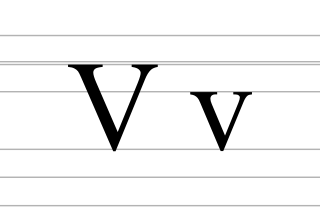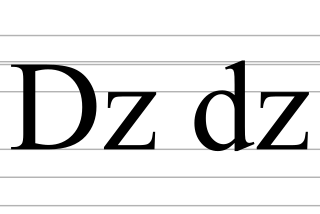Related Research Articles

D, or d, is the fourth letter of the Latin alphabet, used in the modern English alphabet, the alphabets of other western European languages and others worldwide. Its name in English is dee, plural dees.

G, or g, is the seventh letter of the Latin alphabet, used in the modern English alphabet, the alphabets of other western European languages, and others worldwide. Its name in English is gee, plural gees.

The International Phonetic Alphabet (IPA) is an alphabetic system of phonetic notation based primarily on the Latin script. It was devised by the International Phonetic Association in the late 19th century as a standard written representation for the sounds of speech. The IPA is used by lexicographers, foreign language students and teachers, linguists, speech–language pathologists, singers, actors, constructed language creators, and translators.

N, or n, is the fourteenth letter of the Latin alphabet, used in the modern English alphabet, the alphabets of other western European languages, and others worldwide. Its name in English is en, plural ens.

O, or o, is the fifteenth letter and the fourth vowel letter of the Latin alphabet, used in the modern English alphabet, the alphabets of other western European languages and others worldwide. Its name in English is o, plural oes.

R, or r, is the eighteenth letter of the Latin alphabet, used in the modern English alphabet, the alphabets of other western European languages and others worldwide. Its name in English is ar, plural ars, or in Ireland or.

T, or t, is the twentieth letter of the Latin alphabet, used in the modern English alphabet, the alphabets of other western European languages and others worldwide. Its name in English is tee, plural tees.

V, or v, is the twenty-second letter of the Latin alphabet, used in the modern English alphabet, the alphabets of other western European languages and others worldwide. Its name in English is vee, plural vees.

The voiced alveolar lateral fricative is a type of consonantal sound, used in some spoken languages. The symbol in the International Phonetic Alphabet that represents voiced dental, alveolar, and postalveolar lateral fricatives is ⟨ɮ⟩, and the equivalent X-SAMPA symbol is K\.

The close-mid back unrounded vowel, or high-mid back unrounded vowel, is a type of vowel sound, used in some spoken languages. Its symbol in the International Phonetic Alphabet is ⟨ɤ⟩, called "ram's horn." This symbol is distinct from the symbol for the voiced velar fricative, ⟨ɣ⟩, which has a descender, but some texts use this symbol for the voiced velar fricative.

The voiceless palato-alveolar sibilant affricate or voiceless domed postalveolar sibilant affricate is a type of consonantal sound used in some spoken languages. The sound is transcribed in the International Phonetic Alphabet with ⟨t͡ʃ ⟩, ⟨t͜ʃ ⟩ ⟨tʃ ⟩, or, in broad transcription, ⟨c⟩. This affricate has a dedicated symbol U+02A7ʧLATIN SMALL LETTER TESH DIGRAPH, which has been retired by the International Phonetic Association but is still used. The alternative commonly used in American tradition is ⟨č⟩. It is familiar to English speakers as the "ch" sound in "chip".
Unicode has subscripted and superscripted versions of a number of characters including a full set of Arabic numerals. These characters allow any polynomial, chemical and certain other equations to be represented in plain text without using any form of markup like HTML or TeX.

The voiceless retroflex lateral fricative is a type of consonantal sound, used in some spoken languages. The 'implicit' IPA letter for this sound, ⟨ꞎ⟩, is overtly supported by the extIPA.

L, or l, is the twelfth letter of the Latin alphabet, used in the modern English alphabet, the alphabets of other western European languages and others worldwide. Its name in English is el, plural els.

Heng is a letter of the Latin alphabet, originating as a typographic ligature of h and ŋ. It is used for a voiceless y-like sound, such as in Dania transcription of the Danish language.
Unicode supports several phonetic scripts and notation systems through its existing scripts and the addition of extra blocks with phonetic characters. These phonetic characters are derived from an existing script, usually Latin, Greek or Cyrillic. Apart from the International Phonetic Alphabet (IPA), extensions to the IPA and obsolete and nonstandard IPA symbols, these blocks also contain characters from the Uralic Phonetic Alphabet and the Americanist Phonetic Alphabet.

Dz is a digraph of the Latin script, consisting of the consonants D and Z. It may represent, , or, depending on the language.
In typesetting, the hook or tail is a diacritic mark attached to letters in many alphabets. In shape it looks like a hook and it can be attached below as a descender, on top as an ascender and sometimes to the side. The orientation of the hook can change its meaning: when it is below and curls to the left it can be interpreted as a palatal hook, and when it curls to the right is called hook tail or tail and can be interpreted as a retroflex hook. It should not be mistaken with the hook above, a diacritical mark used in Vietnamese, or the rhotic hook, used in the International Phonetic Alphabet.

The voiced retroflex lateral fricative is a type of consonantal sound. The 'implicit' IPA letter for this sound, ⟨𝼅⟩, is overtly supported by the extIPA. The sound may also be transcribed as a raised approximant, ⟨ɭ˔⟩.
References
- ↑ "Unicode character database". The Unicode Standard. Retrieved 2023-07-26.
- ↑ "Enumerated Versions of The Unicode Standard". The Unicode Standard. Retrieved 2023-07-26.
- ↑ Kirk Miller & Michael Ashby, L2/20-252R Unicode request for IPA modifier-letters (a), pulmonic
- ↑ Kirk Miller & Michael Ashby, L2/20-253R Unicode request for IPA modifier letters (b), non-pulmonic.
- ↑ Kirk Miller & Michael Ashby, L2/21-040 Addendum to Unicode requests for IPA modifier letters, L2/20-252 pulmonic and L2/20-253 non-pulmonic
- ↑ Kirk Miller & Martin Ball, L2/20-116R Expansion of the extIPA and VoQS.
- ↑ Michael Everson and Kirk Miller, Consolidated code chart including proposed phonetic and medieval characters, 2020-01-03
- ↑ Deborah Anderson, Manish Goregaokar, Jan Kučera, Ken Whistler, Roozbeh Pournader, and Peter Constable, Recommendations to UTC #179 April 2024 on Script Proposals, 2024-04-18